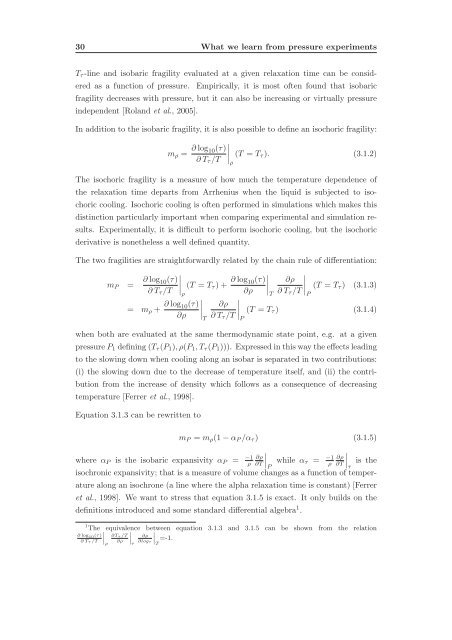Ph.D. thesis (pdf) - dirac
Ph.D. thesis (pdf) - dirac
Ph.D. thesis (pdf) - dirac
Create successful ePaper yourself
Turn your PDF publications into a flip-book with our unique Google optimized e-Paper software.
30 What we learn from pressure experiments<br />
T τ -line and isobaric fragility evaluated at a given relaxation time can be considered<br />
as a function of pressure. Empirically, it is most often found that isobaric<br />
fragility decreases with pressure, but it can also be increasing or virtually pressure<br />
independent [Roland et al., 2005].<br />
In addition to the isobaric fragility, it is also possible to define an isochoric fragility:<br />
m ρ = ∂ log 10(τ)<br />
∂ T τ /T<br />
∣ (T = T τ ). (3.1.2)<br />
ρ<br />
The isochoric fragility is a measure of how much the temperature dependence of<br />
the relaxation time departs from Arrhenius when the liquid is subjected to isochoric<br />
cooling. Isochoric cooling is often performed in simulations which makes this<br />
distinction particularly important when comparing experimental and simulation results.<br />
Experimentally, it is difficult to perform isochoric cooling, but the isochoric<br />
derivative is nonetheless a well defined quantity.<br />
The two fragilities are straightforwardly related by the chain rule of differentiation:<br />
m P = ∂ log 10(τ)<br />
∂ T τ /T<br />
= m ρ + ∂ log 10(τ)<br />
∂ρ<br />
∣ (T = T τ ) + ∂ log 10(τ)<br />
∂ρ<br />
ρ<br />
∂ρ ∣<br />
T<br />
∂ T τ /T ∣ (T = T τ ) (3.1.3)<br />
P ∣<br />
∂ρ<br />
∂ T τ /T ∣ (T = T τ ) (3.1.4)<br />
P<br />
∣<br />
T<br />
when both are evaluated at the same thermodynamic state point, e.g. at a given<br />
pressure P 1 defining (T τ (P 1 ), ρ(P 1 , T τ (P 1 ))). Expressed in this way the effects leading<br />
to the slowing down when cooling along an isobar is separated in two contributions:<br />
(i) the slowing down due to the decrease of temperature itself, and (ii) the contribution<br />
from the increase of density which follows as a consequence of decreasing<br />
temperature [Ferrer et al., 1998].<br />
Equation 3.1.3 can be rewritten to<br />
m P = m ρ (1 − α P /α τ ) (3.1.5)<br />
where α P is the isobaric expansivity α P = −1 ∂ρ<br />
ρ ∂T<br />
∣ while α τ = −1 ∂ρ<br />
P<br />
ρ ∂T<br />
∣ is the<br />
τ<br />
isochronic expansivity; that is a measure of volume changes as a function of temperature<br />
along an isochrone (a line where the alpha relaxation time is constant) [Ferrer<br />
et al., 1998]. We want to stress that equation 3.1.5 is exact. It only builds on the<br />
definitions introduced and some standard differential algebra 1 .<br />
1 The equivalence between equation 3.1.3 and 3.1.5 can be shown from the relation<br />
˛ ∂T τ /T ˛ ∂ρ<br />
∂ρ ∂log τ<br />
˛˛˛T=-1.<br />
∂ log 10 (τ)<br />
∂ T τ /T<br />
˛ρ<br />
˛τ

















